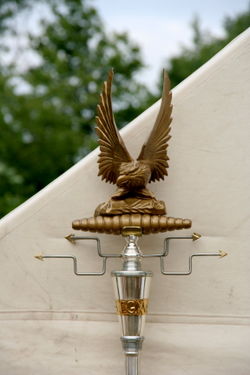History
It was founded in 41 or 40 BC by Augustus. [2] Their first assignment was in Sicily where Sextus Pompey, son of Pompey, was leading a revolt. This revolt put Rome's grain supply in peril and it needed a harsh response.
In 30 BC, veterans of the XIX legion were settled near Pisa, [1] and after that, the rest of the legion was allocated in the Rhine frontier with base camp at Cologne. The XIX legion participated in the German campaigns of Drusus (13–9 BC) and Tiberius (8–5 BC). By the year 5 BC Germania was a Roman province and Publius Quinctilius Varus was assigned as governor.
The legion could have been stationed in Dangstetten. It is possible the reason the legion was stationed here was to police the nearby Roman Road. [3] [4]
In September 9 AD, Arminius, leader of the Cherusci and a Roman ally, set a trap. He had reported a major revolt of one of the western tribes and suggested the return of both governor and his legions to the Rhine. Varus accepted the suggestion and went with the XVII, XVIII and XIX legions. The army was trapped near Osnabrück and was completely destroyed in the Battle of the Teutoburg Forest. Between 16 and 18, Germanicus, the leader of the Rhine armies, looked for the remains of the legions. The Legion XIX Eagle was captured by the Bructeri. [3] [5] In 15 AD troops under the command of Lucius Stertinius rescued the eagle: [6] After its destruction, the Romans never used this legion number again.
This page is based on this
Wikipedia article Text is available under the
CC BY-SA 4.0 license; additional terms may apply.
Images, videos and audio are available under their respective licenses.

